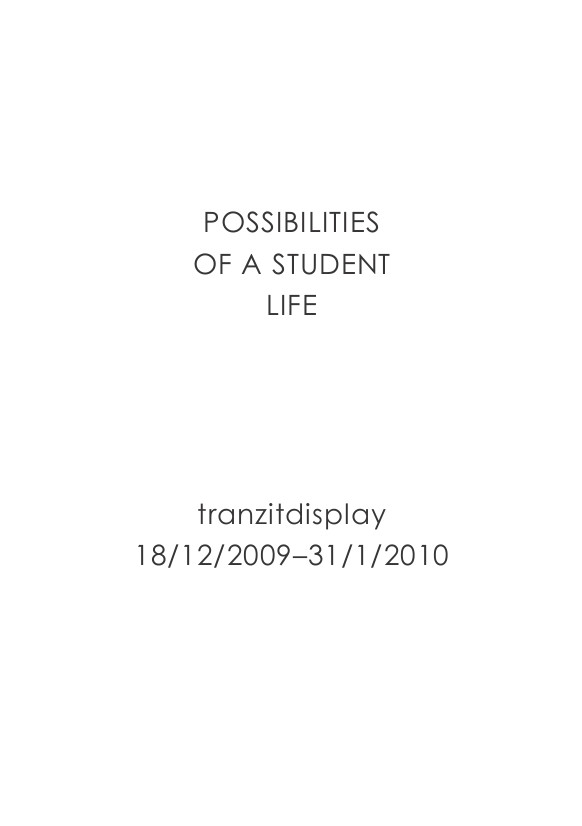Možnosti studentského života (2010) [Czech]
Filed under brochure | Tags: · activism, democracy, education, protest

Možnosti studentského života je průběžně rozvíjený projekt skupiny P. O. L. E. (aktuálně působící ve složení Vasil Artamonov, Alexey Klyuykov, Václav Magid, Tereza Stejskalová, Pavel Sterec, Tomáš Uhnák), který formou výstavy seznamuje s různými pojetími společenské role studujících.
Projekt má několik složek. Faktografická část poskytuje základní vhled do dějin studentstva jako společenského fenoménu. Tvoří ji jednak graf, jenž lokalizuje klíčové události a hnutí na časové a zeměpisné ose, jednak medailonky vybraných osobností studentského aktivismu. Teoretická část přibližuje formou citátů různé koncepce identity studujících. Jako zdroj těchto pojetí posloužily manifesty studentských hnutí a úvahy některých myslitelů. Další složka projektu má podobu multimediální instalace, koláže z plakátů a letáků či sestřihu videí a ukazuje obraz studujících jako specifické skupiny konzumentů, jenž je dnes prosazován reklamou a masmédií. Nedílnou součástí projektu jsou také bannery a další předměty používané při pouličních protestech. Tyto artefakty, ať už převzaté od různých studentských uskupení nebo vyrobené samotnými autory projektu, jsou v závislosti na kontextu prezentace aranžovány do podoby muzeální instalace nebo naopak začleňovány do aktuálně probíhajících protestů.
Původní verze výstavy byla připravena ve spolupráci se Studentskou komorou RVŠ pro galerii TranzitDisplay v roce 2009 u příležitosti sedmdesátého výročí 17. listopadu 1939. Aktualizované reprízy proběhly v roce 2011 v galerii D9 v Českých Budějovicích a v klubu K4 v Praze. Pro prezentaci na Filozofické fakultě UK v rámci Týdne neklidu autoři přepracovali projekt tak, aby se stal nedílnou součástí protestů proti připravované reformě vysokých škol.
Edited by Vasil Artamonov, Patrik Eichler, Miroslav Jašurek, Václav Magid, Tomáš Uhnák
Publisher tranzitdisplay, Prague
80 pages
Krisis: Journal for Contemporary Philosophy, 3: Civil Disobedience (2012)
Filed under journal | Tags: · activism, disobedience, occupy movement, philosophy, politics, protest, resistance, theory

“Some of the most prominent theories of civil disobedience, e.g. those of Rawls and Habermas, highlight its primarily or even exclusively symbolic character. This, however, seems to reduce civil disobedience to a purely moral appeal. On a theoretical as well as on a practical level we are today faced with the question whether civil disobedience requires a moment of real confrontation for it to be politically effective. It seems that civil disobedience does in fact have an irreducible symbolic dimension, but that it cannot be reduced to this dimension, because without moments of real confrontation it would also lose its symbolic power and turn into a mere appeal to the conscience of the powers that be. The articles in this special section highlight various of the challenges and possibilities the theory and practice of civil disobedience is confronted with today, from the question whether Paraguayan campesinos have a right of necessity also to uncivil actions via the political potential of the apparently criminal behaviour of marginalized migrants and the effects of ‘hermeneutic invisibility’ on the public nature of civil disobedience to the effects rise of ‘art activism’ on the relation between the social and the artistic and the situatedness of the bodies of protesters in relation to changing police tactics.
In ‘The Misadventures of Critical Thinking’ Jacques Rancière explores the anti-emancipatory effect of an artistic and theoretical critique that specializes in unmasking how all attempts at critique are always already anticipated and incorporated by ‘the system’, suggesting that we should instead focus on what he calls ‘scenes of dissensus’. As Joost de Bloois argues in his comment on Rancière’s text, however, this analysis might not only underestimate the complexity of this unmasking critique, it also seems to run into some of the same problems it diagnoses.
In our interview with Wendy Brown we discuss the emancipatory potential as well as the theoretical and political limits of the notions of democracy and communism, the paranoid practice of walling with which states seem to compensate their waning sovereignty, the Occupy movement and the danger of Oedipalization, the varieties of secularism, and the responsibility of teaching.”
Published in Amsterdam, 2012
101 pages
via Jappe Groenendijk
Alain Badiou: The Rebirth of History: Times of Riots and Uprisings (2011–)
Filed under book | Tags: · arab spring, cultural revolution, egypt, france, islam, marxism, power, protest, revolution, riot

“Testing the winds of history blowing from the Arab revolts.
In the uprisings of the Arab world, Alain Badiou discerns echoes of the European revolutions of 1848. In both cases, the object was to overthrow despotic regimes maintained by the great powers—regimes designed to impose the will of financial oligarchies. Both events occurred after what was commonly thought to be the end of a revolutionary epoch: in 1815, the final defeat of Napoleon; and in 1989, the fall of the Soviet Union. But the revolutions of 1848 proclaimed for a century and a half the return of revolutionary thought and action. Likewise, the uprisings underway today herald a worldwide resurgence in the liberating force of the masses—despite the attempts of the ‘international community’ to neutralize its power.
Badiou’s book salutes this reawakening of history, weaving examples from the Arab Spring and elsewhere into a global analysis of the return of emancipatory universalism.”
Originally published as Le Reveil de l’histoire, Nouvelles Editions Lignes, 2011
Translated by Gregory Elliott
Publisher Verso Books, 2012
ISBN 1844678792, 9781844678792
126 pages
Reviews: Jasper Bernes and Joshua Clover (Los Angeles Review of Books), Daniel Tutt (Platypus), Anindya Bhattacharyya (Socialist Review).
PDF (updated on 2020-7-5)
Comment (0)
